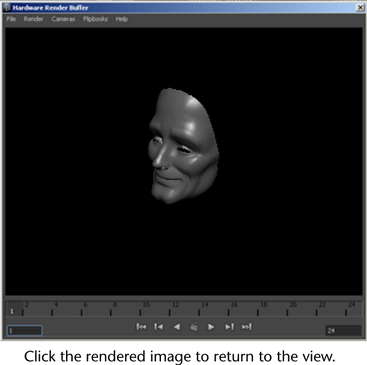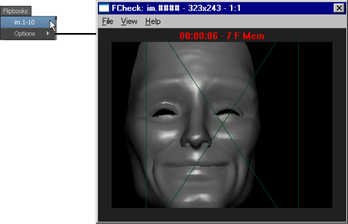File menu
Contains the Close option. Either click the box at the top right of the window or select this option to close the Hardware Render Buffer window.
Render menu
Contains options for setting rendering attributes, rendering a frame or sequence of frames, and controlling the display of the Hardware Render Buffer.
- Attributes
-
Opens the Attribute Editor and displays Hardware Render Buffer Render Settings. For details, see Hardware Render Buffer window.
- Test Render
-
Test-renders the current frame in the Hardware Render Buffer.

- Render Sequence
-
Select to render the current animation.
- Scale Buffer
-
Scales the size of the Hardware Render Buffer so the rendered image is 100%, 70%, 50%, 30%, or 10% of the Resolution.
Tip:- Set Scale Buffer to 100% for the final render.
- Scaling down the size of the rendered image decreases the amount of rendering time required and increases the speed of playback.
- A dimmed Scale Buffer option (percentage) means that the rendered image would either be too large to display on the screen, or too small to see adequately.
- Time Slider
-
Displays the time slider and transport controls at the bottom of the Hardware Render Buffer. Click to turn the Time Slider at the bottom of the window on or off.
Tip: In the Hardware Render Buffer window, Render > Attributes... window, unsupported image file formats appear in the Image Format drop-down list. The following are the supported image file formats: Tiff, Tiff16, SGI, MayaIFF, JPEG, Maya16IFF, Targa, Windows Bitmap, MacPaint, Photoshop, PNG, QuickDraw, and Quick Time Image.When you select another (unsupported) format from the drop-down list, Maya renders the image as an .iff file.
Cameras menu
The view in the Hardware Render Buffer is actually a copy of the corresponding camera view. For example, if the camera view displays the resolution gate, the Hardware Render Buffer view also displays the resolution gate.
The Cameras menu contains a list of all cameras in the scene. Select a camera view by selecting it from the Cameras menu. For example, if you select camera 1, the Hardware Render Buffer displays the view as seen from the camera. If side, it displays the side view.

You can select and move objects in the Hardware Render Buffer view just as you would in a regular view. You can also adjust the camera in the Hardware Render Buffer using the ![]() (Linux and Windows) or Option (Mac OS X) key and the left, middle or right mouse buttons.
(Linux and Windows) or Option (Mac OS X) key and the left, middle or right mouse buttons.
When you playback an animation in the Hardware Render Buffer, it also plays back in the corresponding view. To make an animation play back only in the Hardware Render Buffer, click anywhere in the Hardware Render Buffer view while the animation is playing.
Make sure nothing on the screen covers any part of the Hardware Render Buffer during rendering. (Hardware rendering uses screen captures to create rendered frames.)
Flipbooks menu
The Flipbooks menu contains the list of sequences you rendered in the Hardware Render Buffer (if you selected Render Sequence from the Render menu) as well as the Clear Flipbook Menu option and Flipbook Flags.

The Flipbooks Options control how sequences of images rendered from the Hardware Render Buffer display and displays the Flipbook Options window.
Flipbook Options
These options control how sequences of images rendered from the Hardware Render Buffer are displayed.

Options
Enter fcheck options to be used when playing back a hardware rendered sequence of images (by selecting the sequence from the Flipbooks menu of the Hardware Render Buffer).
- Clear Flipbook Menu
-
Removes any rendered sequences of images from the Flipbooks menu.
- Flipbook Flags
-
Displays the Flipbook Options window. This option in available for only Linux and Windows.
See also “fcheck” in the Rendering Utilities online documentation for information on fcheck options.
Time slider and transport controls
The time slider and transport controls in the Hardware Render Buffer are similar to the time slider and transport controls in the main Maya window. See the Animate > Create Animated Sweep in the Animation guide for details about the Time Slider.